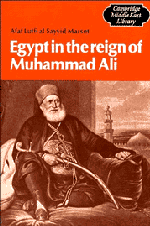Book contents
- Frontmatter
- Contents
- Dedication
- Preface
- Note on transliteration
- 1 Egypt under the mamluks
- 2 Muhammad Ali the man
- 3 A country without a master
- 4 Master in his own house
- 5 Family, friends and relations
- 6 Internal policies
- 7 Agricultural changes
- 8 Industry and commerce
- 9 Expansion to what end?
- 10 The undoing: Muhammad Ali and Palmerston
- 11 The aftermath
- 12 Conclusion
- Notes
- Glossary of Arabic and Turkish terms
- Select bibliography
- Index
11 - The aftermath
Published online by Cambridge University Press: 04 April 2011
- Frontmatter
- Contents
- Dedication
- Preface
- Note on transliteration
- 1 Egypt under the mamluks
- 2 Muhammad Ali the man
- 3 A country without a master
- 4 Master in his own house
- 5 Family, friends and relations
- 6 Internal policies
- 7 Agricultural changes
- 8 Industry and commerce
- 9 Expansion to what end?
- 10 The undoing: Muhammad Ali and Palmerston
- 11 The aftermath
- 12 Conclusion
- Notes
- Glossary of Arabic and Turkish terms
- Select bibliography
- Index
Summary
The frustrations of these few months might have destroyed a less determined man than Muhammad Ali, or at least might have broken his spirit. Many historians have assumed that his spirit indeed was broken, and have claimed that he lost interest in his industries and his schools after 1840, when the momentum slowed down. That was not the case. Internal changes did take place after 1841, but they were necessitated by the changing circumstances of the country and its changing financial potential.
Before the Syrian débâcle the Egyptian government had been heading towards expansion overseas and control of trade routes, if not of the resources of the countries they had occupied. After 1841 expansion was replaced by contraction to the territories of Egypt and the Sudan. Egypt no longer controlled trade routes, and had to rely on her own resources or on normal trade patterns. This affected Egyptian industry as did the new trade tariffs that were now imposed.
Prior to 1841 Egypt had a large army that reached well over 100,000 men (some figures, e.g., those of Sami, give twice that number). While that army had siphoned manpower away from agriculture and industry, such a large army consumed the products of the new industries in terms of cloth for uniforms, leather for boots, saddles and gear, firearms and gunpowder, cannon and ships, and all the products of the arsenals and shipyards in terms of sails, ropes, copper plates, metal ware, etc.
- Type
- Chapter
- Information
- Egypt in the Reign of Muhammad Ali , pp. 249 - 257Publisher: Cambridge University PressPrint publication year: 1984

